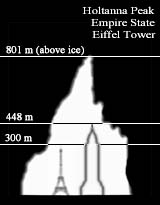|







|


|





|
DISPATCHE
1 : 2 - 9 December
 Saturday
December 9th: first frights (from
Capetown)
Saturday
December 9th: first frights (from
Capetown)
Last Thursday, there was
a small accident on one of the Cape Town beaches. Which did not
inspire confidence. And which could easily have handicapped the
project's progress.
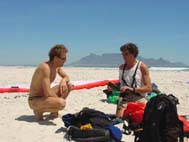 Still
waiting for the departure and taking advantage of this dead period
to carry out all kinds of tests, the group decided to go to the
beach, but not for the purposes of lounging about and getting a
tan. But to test the sails. The Powerkites no longer have a leading
role to play in this expedition, unlike the situation three years
ago at the time of the great crossing. But still: from Blue One,
part of the team was to get to Holtanna, a distance of some 80 km,
under sail. A question of saving the cost of the Twin Otter and
of getting familiarised with the icy environment. So the sails were
on the Still
waiting for the departure and taking advantage of this dead period
to carry out all kinds of tests, the group decided to go to the
beach, but not for the purposes of lounging about and getting a
tan. But to test the sails. The Powerkites no longer have a leading
role to play in this expedition, unlike the situation three years
ago at the time of the great crossing. But still: from Blue One,
part of the team was to get to Holtanna, a distance of some 80 km,
under sail. A question of saving the cost of the Twin Otter and
of getting familiarised with the icy environment. So the sails were
on the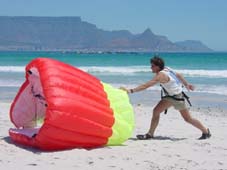 journey. They had not only to be tested one last time but also and
especially the people who were still unfamiliar with this contraption
had to be taught how to manipulate it. The wind was fairly strong
(50 kph), as always on this town beach. And suddenly, when it
was Ralf Dujmovits' turn to try the Powerkites, he was carried up
into the air to a height of more than three metres above the ground.
journey. They had not only to be tested one last time but also and
especially the people who were still unfamiliar with this contraption
had to be taught how to manipulate it. The wind was fairly strong
(50 kph), as always on this town beach. And suddenly, when it
was Ralf Dujmovits' turn to try the Powerkites, he was carried up
into the air to a height of more than three metres above the ground.
Exactly the same misadventure happened to Dixie, on 04 December
1997 (see
details) during the transantarctic crossing with Alain. With
one difference, all the same: the fall is less brutal on sand than
on ice. Nevertheless, Dujmovits was not moving. 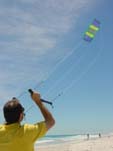 He
was quickly taken to the nearest hospital, and cerebral concussion
was diagnosed; for more than two hours, Ralf could not remember
anything, and was all the time asking his companions what he was
doing there and why he had to go off on an expedition in the Antarctic! He
was quickly taken to the nearest hospital, and cerebral concussion
was diagnosed; for more than two hours, Ralf could not remember
anything, and was all the time asking his companions what he was
doing there and why he had to go off on an expedition in the Antarctic!
At the end of the day, no harm was done; the next day, the doctor
gave his green light for his participation in the expedition. Hubert
gave me one of the explanations for this just this afternoon: the
new sails taken by the expedition were far more vicious than the
earlier ones. More efficient, but also trickier to handle. On Saturday
afternoon, the group did it all again, because the Illyushin had
still not arrived. And this time all went well.
Here is
a short story written by Lisa, a guide who is located at
Blue One Station ; together with Ronald Ross, they went
on a small balade to collect lichens near a nunatak.
Lichens in the Snowstorm
There were four of us as we set off; one in town shoes with
magic little chains added to stop him slipping on the ice,
one armed with a data logger and crampons to disturb the
peace of the lichens, one skiing and dragging a sledge and
one who thought her mukluks alone would be fine on the ice.
The last one came back with big bruises on her knees, the
sledger had a very exciting sideways slide down an icy slope
with no bottom, the town walker took videos of the whole
outing including the death slide and the data logger came
back happy.
The mission was to find some more lichen on the
'wall nunatak' and leave a data logger at the site for the
next year.
Not long after setting out the snow started to fall gently
but it was still warm enough to sweat as we walked along
as a jolly little bunch, chatting about we were going to
become famous ecologists. As the snow became thicker we
looked back at the camp, but that had gone long ago along
with the blue ice which was now disguised by two centimetres
of soft, fluffy snow. We carried on, the snow quite  thick
in the air, the visibility down to ten metres or so. We
called the camp on the handheld VHF, to tell them we would
carry on and don't worry, but no one was listening. The
sledger pushed out in front, misunderstanding(?) the advice
NOT to take his sledge on to the knife edge ridge ahead
while the others bunched together to approach the tricky
bit. The sledger had to stop when his sledge slid off to
the left (the right was certain death) and was pulling him
where he didn't want to go. He froze. The one in mukluks
tried to help by grabbing the traces attatching the sledge
to the puller, but she couldn't grip with her boots on the
steep icy slope. They wouldn't let the one in crampons help
in case he was dragged off too. The sledger was told to
take the traces off, let the sledge go and save himself.
He didn't, he pushed on! He started to slide sideways as
the sledge pulled him downwards. He fought against the pull
but it was no good, he was going down. The others just watched,
unable to help, unable to say anything, only thinking "oh
no!" He stopped at the bottom, only 10 meters away on easy
ground, laughing. The others laughed nervously with him.
The sledge was left behind to recover and they walked on
into the thickening sky; it was getting cold and very white.
The lichens were quickly found, a cairn of rocks built nearby
so that we would identify the site again. They went home
a different way. thick
in the air, the visibility down to ten metres or so. We
called the camp on the handheld VHF, to tell them we would
carry on and don't worry, but no one was listening. The
sledger pushed out in front, misunderstanding(?) the advice
NOT to take his sledge on to the knife edge ridge ahead
while the others bunched together to approach the tricky
bit. The sledger had to stop when his sledge slid off to
the left (the right was certain death) and was pulling him
where he didn't want to go. He froze. The one in mukluks
tried to help by grabbing the traces attatching the sledge
to the puller, but she couldn't grip with her boots on the
steep icy slope. They wouldn't let the one in crampons help
in case he was dragged off too. The sledger was told to
take the traces off, let the sledge go and save himself.
He didn't, he pushed on! He started to slide sideways as
the sledge pulled him downwards. He fought against the pull
but it was no good, he was going down. The others just watched,
unable to help, unable to say anything, only thinking "oh
no!" He stopped at the bottom, only 10 meters away on easy
ground, laughing. The others laughed nervously with him.
The sledge was left behind to recover and they walked on
into the thickening sky; it was getting cold and very white.
The lichens were quickly found, a cairn of rocks built nearby
so that we would identify the site again. They went home
a different way.
Lisa.
Source
: Ronald Ross's website
www.thistle.org
Photo : Upper side view of Umbilicaria aprina, the more
common umbilicate lichen in the Antarctic interior ©
R. Ross
|
 Friday
December 8th (from
Capetown)
Friday
December 8th (from
Capetown)
Since
two days, the luggage of the expedition have been transported to Capetown
airport in order to be ready faster when Iliouchine arrives. No need
to say that the Team is impatiently
waiting for the last phonecall informing them
that finally, the only have to take a taxi and rush to the airport.
Last night, ANI's logistic people told them they should be ready in
a few ours. Having already accompanied Alain Hubert in november 1997,
when he left with Dansercoer for their big traverse, I know that this
kind of situation may last for ...days.
And apparently, that is what's happening because tonight, Friday December
7th, no sight of the plain coming (it has to fly from Punta Arenas).
That said, during these last days, Hubert and his companions have tested
over and over the communcication material ; everything seems to work
OK.
Meanwhile, American Ronald Ross is still waiting in Blue One for the
team to arrive. No time to get bored, he is busy with his satellite
communications and his collecting of
the lichens (see
press communiqué n°4). Tomorrow, we'll publish a story
on a day collecting.
See
in the meantime antarctica.org's follow up and the progression (on the
maps) of the other expeditions struggling with antarctic ice. Solo skier
Stane Klemenc, who had the project to cross all Antarctic unsupported,
has already abandonned, having not gone further than about a hundred
kms from Blue One. See
here the details
 Saturday
December 2nd (from
Capetown)
Saturday
December 2nd (from
Capetown)
Our plane departed Zaventem at 11 o'clock and
we arrived at Johannesburg at 10 in the evening. 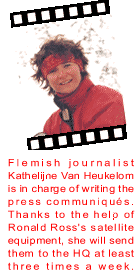 What
we feared most happened : three pieces of our luggage had disappeared.
We checked it, again and again. But we had to leave Johannesburg without
those three pieces of luggage. What
we feared most happened : three pieces of our luggage had disappeared.
We checked it, again and again. But we had to leave Johannesburg without
those three pieces of luggage.
The day after, Alain made a few phone calls and the luggage was found,
thye should arrive in Cape Town in two days. Problem solved.
Arrival at Cape Town at 2 o'clock in the morning (local time). Check
out - waiting - squashed car ride to town ….. at 4.30 in the morning
we saw finally our beds. The view out the window of our apartment is
great. We see the sea, which is rather cold, a marvellous beach and
the silhouette of the Table Mountain.
The following morning we slept long and tried to find some food. We
discovered the surrounding streets, and then in the afternoon did an
interview with Alain.
The moral is perfect in the whole team. We laughed a lot and there is
quite an ambiance in the group. The only problems we have for the moment
concern the doors - they wont open, or they are broken or they were
stuck.
Today (Saturday), we will do some tests with Inmarsat and try out the
computers. Maybe I will take some sound recordings and mix it using
the computer program - just for practice.
Temperature and weather : great ! Sunny and warm (about 30 °)
Kathelijne Van Heukelom
 |


